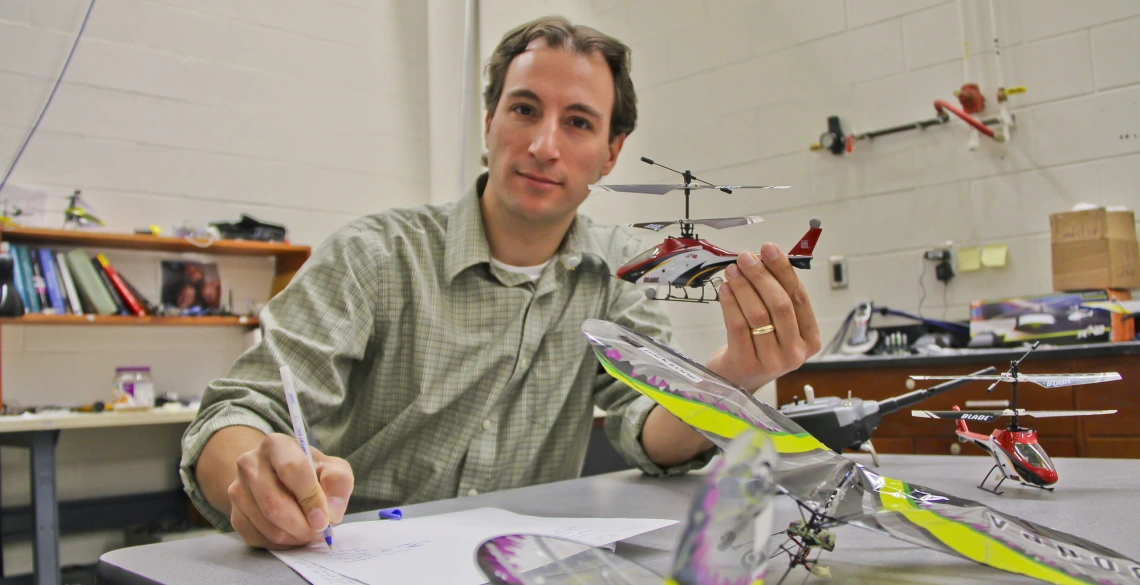Creating the Internet of Everything
Autonomous cars on our streets driving better than we do. Intelligent wallpaper in our houses measuring temperature, moisture and vibration. Smart dust scattered in our hospitals tracking patients or detecting toxins.

Ricardo Sanfelice, assistant professor in the aerospace and mechanical engineering department, in the Hybrid Dynamics and Controls Laboratory. (Photo: Pete Brown)
Imagine networking all the above together to create an internet of everything that can sense and control the myriad processes that once ran silently and anonymously in the backgrounds of our lives.
This mostly invisible mesh of wired and wireless sensor networks that coats our existence is at the heart of "cyber-physical systems," a rapidly growing area of systems engineering.
The UA College of Engineering's Hybrid Dynamics and Controls Laboratory recently hosted the First Southwest Workshop on Theory and Applications of Cyber-Physical Systems. The event, and its 20 speakers, attracted almost 60 researchers from industry, government and about 10 Southwestern colleges.
Ricardo Sanfelice, director of the Hybrid Dynamics and Controls Laboratory and an assistant professor in the aerospace and mechanical engineering department, organized the workshop. The National Science Foundation sponsored the event, which took place March 10-11 at the Four Points by Sheraton hotel in Tucson, Ariz.
Sanfelice noted that the Southwest is active in this area of research. He said this workshop, the first in an ongoing series, "will strengthen much-needed collaboration between universities and laboratories within the region by providing a venue where participants exchange ideas and results."
New Research Areas for Students
Sanfelice also views this series of workshops as an ideal opportunity to involve students in a new area of engineering research. "The workshop will provide graduate students a unique opportunity to present and discuss their results with peers and experienced researchers," he said.
Cyber-physical systems is an emerging field, so it fell to one of its champions, Michael Branicky, to start the workshop by defining what the name actually means. Branicky is a professor of computer science at Case Western Reserve University in Cleveland, and in 2008-2010 was a program director at the NSF, where his research program management included cyber-physical systems.
"Cyber-physical systems really exploit the type of world that we live in today, where things are connected by networks, either wireless or wired," Branicky said. A feature of this environment, he said, is "pervasive sensors and actuators ... and networked computers and sensory control."
Branicky pointed out that this field grew out of embedded systems research, and quoted one researcher in this field who described cyber-physical systems as "embedded systems plus control on steroids."
To illustrate the advances made in embedded systems, Branicky showed a video of Big Dog, a 240-pound 4-legged robot that can carry a payload of 340 pounds over rough terrain. What makes Big Dog work, he said, is "the computers that are inside." He suggested that "people who are deciding how much we should invest in computer research" should watch the video.
"There are computers everywhere. There are also sensors everywhere," Branicky said. "From the redwood forests to the Hudson River valley to the buildings that are in our cities, to the bridges that connect our roads together." An important development from the cyber-physical viewpoint, Branicky said, is the growing number of actuators hooked up to these networks. "Most of these actuators are robots, but there are also actuators inside your body, such as pacemakers and insulin pumps."
After describing cyber-physical systems as omnipresent computers, sensors and actuators, Branicky used the modern automobile to twist the definition to encompass not only what such systems are, but also what they do.
"What makes a car a car?" he asked. "Is it all its physical parts, or is it all its behaviors and capabilities?" To a consumer, Branicky said, a car is what it does, not what it is. "It's all these control loops, all these capabilities," he said, citing systems such as blind-spot detection, cruise control, and voice and data communication via satellite. "Perhaps soon cars even talking to each other."
Systems of Systems
While cyber-physical systems can bring great benefit, they have enormous cost. Cars, aircraft, medical devices, robots – all are complex cyber-physical systems that contain millions of lines of computer code and have to work efficiently and safely. Branicky estimated that half the cost of a new car or passenger airliner goes into developing and validating the software that controls their many capabilities.
Branicky turned to energy grids and spoke about individual smart appliances that could be cyber-physical systems, and smart buildings. "Then you have them all connected through a power grid with a systems-level goal of having less blackouts or net zero energy usage in a region," he said.
Cyber-physical systems have huge potential in health care. In a hospital, data flows out of embedded medical devices, surgical robots, and various sensors hooked up to patients. Cyber-physical systems could provide a virtual patient chart that is continuously updated when a patient leaves the hospital, and Branicky predicts "medicines being updated automatically as you're walking around."
"This sort of 24/7 monitoring and treatment is going to change healthcare," Branicky said.
Branicky anticipates the growth of "computational and physical substrates," such as smart dust and paint or wallpaper loaded with sensors that require almost no power. "That sort of thing is possible," he said. Distributed sensors now exist that are "so low power that they would last for 20-30 years on a single lithium coin battery."
Branicky noted that developments in cyber-physical systems were pressing engineers to re-evaluate some fundamental views about computer engineering. "What does it mean to be intelligent?" he asked. "This is the kind of thing that as engineers we're going to have to answer."

